Colorectal
Operations
Operations
For most patients, surgery is the mainstay of treatment for colorectal cancer. Other treatments may be used in addition. The type of surgery depends on the exact nature of each cancer.
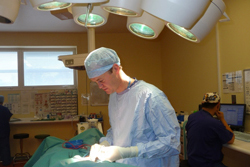
Surgeon Chris John in theatre
The RUH offers access to minimally invasive, conventional and endoluminal surgery. The most common operations are described here:
- Right Hemicolectomy
- Extended Right Hemicolectomy
- Left Hemicolectomy
- Sigmoid Colectomy
- Hartmann's Procedure
- Anterior Resection
- Abdomino - Perineal Excision of Rectum (APER)
- Endoluminal Surgery
Right Hemicolectomy
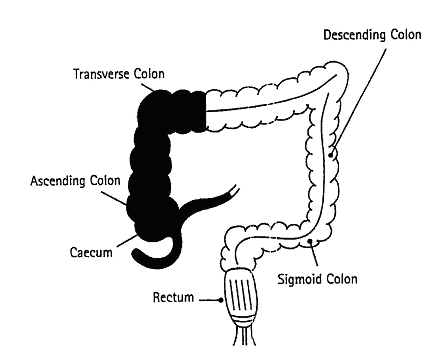
Your operation may be performed partially or completely using a laparoscopic technique (key hole surgery) and this will result in several small incisions on your abdomen.
The abdomen is also opened with a vertical incision which goes around the umbilicus (tummy button). The caecum, appendix and ascending colon and right side of transverse colon are removed together with a few centimetres of small bowel.
Continuity is restored by joining the two ends of bowel back together. The shaded area is the part of the bowel that will be removed.
Extended Right Hemicolectomy

Your operation may be performed partially or completely using a laparoscopic technique (key hole surgery) and this will result in several small incisions on your abdomen.
The abdomen is also opened with a vertical incision which goes around the umbilicus (tummy button). The caecum, appendix, ascending colon and transverse colon are removed together with a few centimetres of small bowel.
Continuity is restored by joining the two ends of bowel back together. The shaded area is the part of the bowel that will be removed.
Left Hemicolectomy
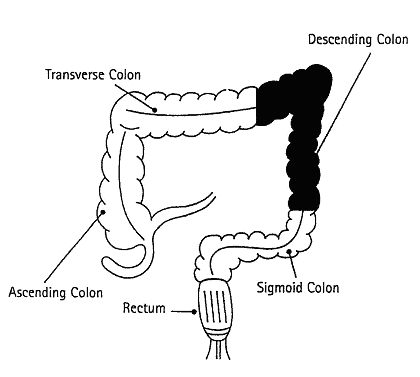
Your operation may be performed partially or completely using a laparoscopic technique (key hole surgery) and this will result in several small incisions on your abdomen.
The abdomen is also opened with a vertical incision which goes around the umbilicus (tummy button). Part of the transverse colon or descending colon is removed.
Continuity is restored by joining the two ends of bowel back together. The shaded area is the part of the bowel that will be removed.
Sigmoid Colectomy
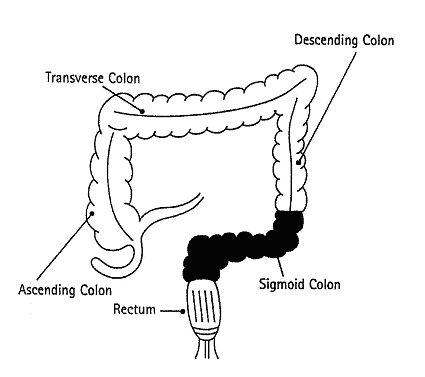
Your operation may be performed partially or completely using a laparoscopic technique (key hole surgery) and this will result in several small incisions on your abdomen.
The abdomen is also opened with a vertical incision which goes around the umbilicus (tummy button).
The sigmoid colon is removed and continuity is restored by joining the two ends – the descending colon and rectum back together. The shaded area is the part of the bowel that will be removed.
Hartmann's Procedure
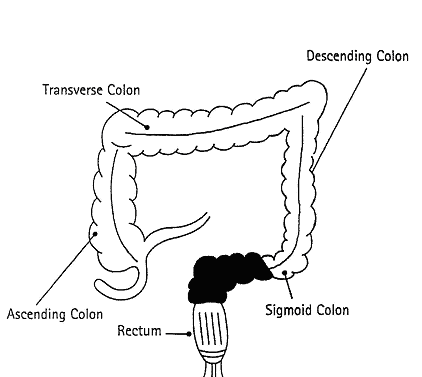
The abdomen is opened with a vertical incision and the diseased section of bowel removed.
A colostomy is made out of the sigmoid colon and the rectum is over sewn so it finishes in a blind end. The shaded area is the part of the bowel that will be removed.
Anterior Resection
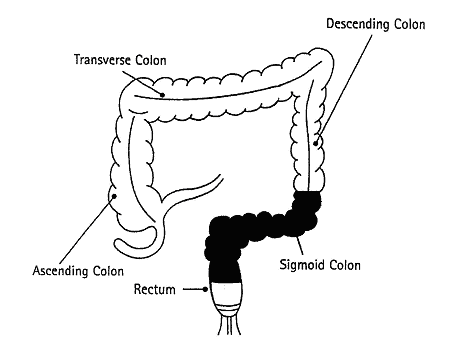
Your operation may be performed partially or completely using a laparoscopic technique (key hole sugery) and this will result in several small incisions on your abdomen.
The abdomen is also opened with a vertical incision which goes around the umbilicus (tummy button). The low part of the sigmoid colon or the high part of the rectum are removed.
Continuity is restored by joining the two ends together. The shaded area is the part of the bowel that will be removed.
A stoma may be formed on a temporary basis to allow the surgical join to heal. Ultimately you will have a small operation to remove this stoma and re-enable normal bowel function.
Abdomino — Perineal Excision of Rectum (APER)
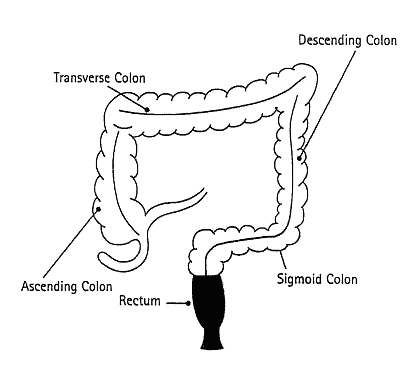
The abdomen is opened with a vertical incision.
The rectum and anus are removed through a second incision in the perineum (bottom).
A stoma is formed out of the sigmoid colon. The shaded area is the part of the bowel that will be removed.
Endoluminal Surgery
Some small cancers can be curatively excised by a telescope passed through the anus. This procedure is only suitable for specific cases but avoids the need for an abdominal scar or removal of a section of the bowel.
Next Section: After Your Operation


